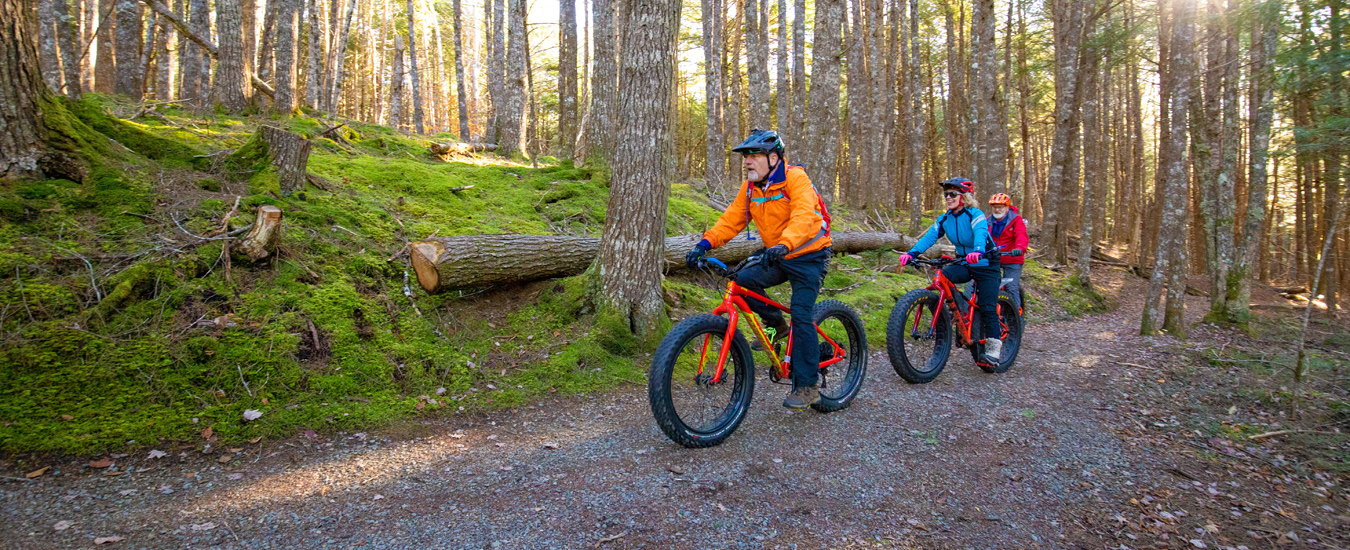Ukme’k translates from Mi’kmaq as “twisted,” a meaning that’s obvious from the start. Hopping on our bikes in the parking lot and hitting the Ukme’k Trail behind the visitor centre in Nova Scotia’s Kejimkujik National Park, my cycling buddy Les and I are immediately into tight turns and short dives, before we hit a wooden bridge. From here, the trail dips and twists. I’m ducking around trees, then up off my seat, leaning into turns. As the trail descends, I whoop and let the bike find its own momentum.
Just a few minutes in, the roar of water grows louder. We pull up at Mill Falls. From the lookoff, we watch the Mersey River plunge jagged slate shelves that turn the black-brown flow into frothy root beer. Interpretative signs explain that the water is nicknamed “Mersey tea,” because it’s created as the river seeps through peat bogs. Tannins stain the water while saponins act as natural soaps, billowing into stable foam as the river tumbles over Mill Falls.
We climb back on the bikes, but stop again almost immediately, this time mid-span on a new bridge for another view of Mill Falls. From one end to the other, the 6.3-kilometre trail follows the river, sometimes crossing it, usually running within sight of it, either at water level or from high on a forested ridge. “This is a beautiful river ride,” Les muses. “It changes a lot, from falls to still waters.”
This is just one of six park trails, most near water, ranging from the family friendly “Flowing Waters” to the difficult 20-kilometre “Eel Weir to Fire Tower” trail. All are portals into the history of this park as a Mi’kmaw meeting place where interconnected waterways merge. Keji’s heritage, including Canada’s second largest collection of petroglyphs, makes it the country’s only national park with national historic site status.
Ukme’k is Keji’s only trail with a Mi’kmaw name. It’s also the park’s newest trail, and the only one built with mountain biking in mind. Signs ask cyclists to yield to pedestrians and warn of “Bikes descending at speed.” Across the bridge, we encounter rock gardens, sections of trail bed expertly constructed from relatively flat rocks, set in low-lying areas to prevent trail erosion. Unavoidable, these are easy to wheel a bike across, but we rattle over them with ease, even at their greatest concentration, an 850-metre section between two side trails, Beech Grove and Flowing Waters.

In the same area, we discover the first of many natural features adapted as technical challenges, all marked with black-diamond signs. Most features are small boulders with dirt or stone approaches and exits. They’re quick and easy diversions at the edge of the trail. Alternatively, they’re easy to avoid, if they seem too difficult or dangerous.
When we come across the only double black diamond sign on the trail, we entertain ourselves by listing all the reasons the “roll-able boulder drop” is beyond our abilities. From a flat, gravel approach, the trail launches the cyclist over a smooth boulder the size of a compact car. “You’ve got to have momentum to be elevated so your front wheel doesn’t drop down,” Les says. “But then you suddenly have to brake because you’re either going to hit that tree or make a 90-degree turn.” We ride on, humbled by the idea that skilled riders can master the obstacle.
“The most fun are the rollers and berms,” says Les. Like rock gardens, the rollers are part of the trail bed, so we lift and drop, lift and drop over them like skiers bumping over moguls. The berms are banked turns built on tight corners, up to five in a series—avoidable, but easily taken at higher speeds. Navigating both of these features has me whooping once again.
Just before the trail ends, it joins the paved road at a rainbow crosswalk painted in the eleven colours of the Progress Pride Flag, a symbol of Keji’s message that everyone is welcome and safe in the park. On the other side, we ride the short distance to the spot where the Ukme’k Trail merges with the Mersey River Trail. From here, cyclists can continue on to Merrymakedge Beach, a ride that doubles the distance. Pleased with our experience, we return on the paved road to the visitor centre, a ride that’s anything but twisted and has me regretting we didn’t keep going.
“I’d do it again,” Les echoes my thoughts. “Maybe extend the ride to another part of the park.” We’ll be back, next time to ride all the way to Merrymakedge.
Four more Nova Scotia cycling adventures
Keppoch Mountain
Once known as a ski hill, “the Keppoch” near Antigonish is now a mountain biker’s playground. Nine downhill trails with names like Oldie Roller and Chicken Cougar are for mountain bike traffic only. Trails drop down steep slopes and are colour coded according to difficulty.
Wentworth Trail
Wentworth is a ski hill that caters to mountain bikers (including a ski-lift zone) who want to ride the Wentworth Trail, a course designed with mountain biking in mind. A steep climb up or the use of that lift is rewarded with quick downhills that feature many berms for exciting twists and turns.
The Gorge
At the Gorge in Kentville, trails with names like Bottle Rocket, Curious Gorge, and Flying Squirrel vary in difficulty. Those for beginners feature boardwalks and smooth surfaces. Natural features like roots and rocks add to the technical elements that challenge more advanced riders. The skills park at the Gorge is designed for all.
Rum Runners Trail
The 123-kilometre Rum Runners Trail follows an old railway bed from Halifax to Lunenburg. Riders can hop on nearly anywhere along the six sections that make up the complete trail. With no technical elements other than length, it’s ideal for family outings and distance riding through mixed forest and small towns.

